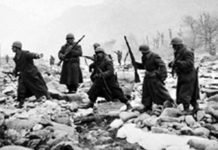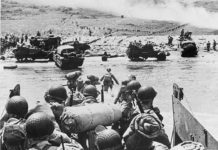Tension mounts in the Indian Wars as Crook’s column is surprise attacked by the same foe he had been pursuing and who would later finish George Custer.
By early June, 1876, Chief Sitting Bull led of one of the largest villages ever documented in Plains Indian history. Throughout the spring, his camp had steadily grown due to the migration of Sioux and Cheyenne from reservations in Dakota and Montana Territories. Though the Battle of Powder River had angered his people, Sitting Bull wished to avoid a major confrontation with the army if possible. He hoped that the size of his forces would dissuade Custer, Crook, and the other commanders in the field from risking a horrific loss and further operations in Montana.
Crook Wakes the Sleeping Giant
That was not to be the case. As General George Crook marched northward through Wyoming and southern Montana, Sitting Bull’s scouting parties sent word of his hostile intentions. Though the enormous Indian village was close to the Dakota and Montana columns of George Custer and John Gibbon, neither side knew the exact location of the other. For the time being, anyway, the Indians were focused on Crook alone.
As Sitting Bull’s village neared the Little Bighorn River, Crook had entered the valley of Rosebud Creek 20 miles to the southeast. His scouts stumbled upon a deserted Cheyenne camp that still had buffalo meat still cooking over a fire. News of the discovery made allied Shoshone and Crow accompanying Crook increasingly nervous. The Cheyennes from the camp slipped away unnoticed and rushed word to Sitting Bull of Crook’s close proximity to his village. Though Sitting Bull stayed behind, Crazy Horse and his Indian warriors rode out to meet them, intent on stopping their advance and eventual attack on their families.
Surprise Attack on Rosebud Creek
At dawn on June 17, Crook’s men were on the march. The column stopped in an open valley along the Rosebud at around eight that morning to allow their horses and mules to graze. Crook again dispatched scouts into the surrounding hills to surveil the area. Nearing the hilltops, they ran head-on into several hundred Sioux and Cheyenne warriors. After exchanging gunfire, the scouts sped back towards Crooks force with the warriors in hot pursuit.
As two wounded Crows ran into the camp warning of the impending attack, Crook deployed skirmishers along the flanks of the hills north and west of his position. Their resistance from the skirmishers and that of the scouts retreating from the hills slowed the advance of the Sioux and gave the rest of the column precious minutes to form a defense.
It became clear to Crook’s men early on that this conflict was going to be different from previous engagements of the Indian Wars. From past experience, the Indians tended to hit a larger enemy by surprise and then quickly withdraw before suffering heavy casualties. Though significantly outnumbered at Rosebud Creek, Crook’s assigned observer [Lt George Bourke] noted that the Indians “were extremely bold and fierce and showed a disposition to come up and have it out hand to hand.”
The Sioux and Cheyenne intended to lead Crook into a trap similar to the one they had sprung on Captain Fetterman in 1866. Crazy Horse would later tell the general, after surrendering to him in 1877, that “his plan of battle was either to lead detachments in pursuit of his people, and turning quickly cut them to pieces in detail, or draw the whole of Crook’s forces down into the canon [sic] of the Rosebud, where escape would have been impossible.”
For the next six hours, the Battle of the Rosebud would rage. Though Crook would not suffer the same fate as Fetterman, his decisions would neutralize his future fighting ability and negatively affect other field commanders in the days to come.








